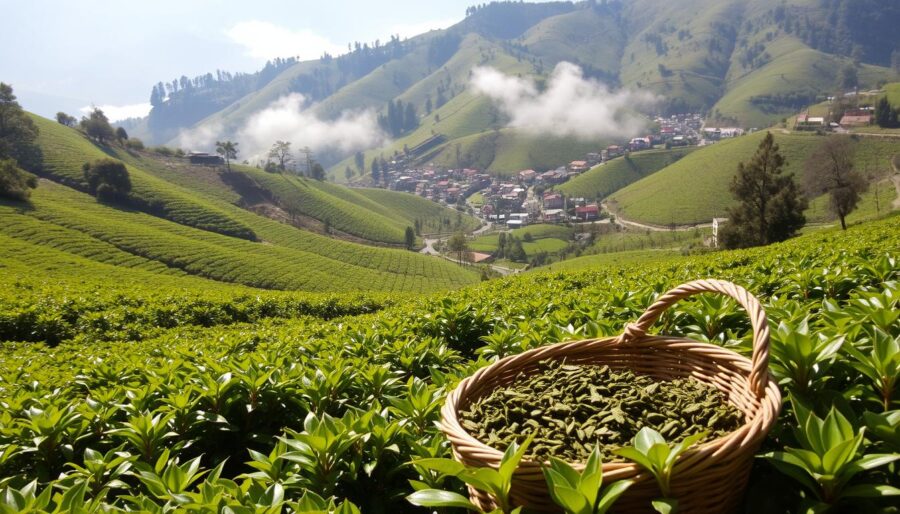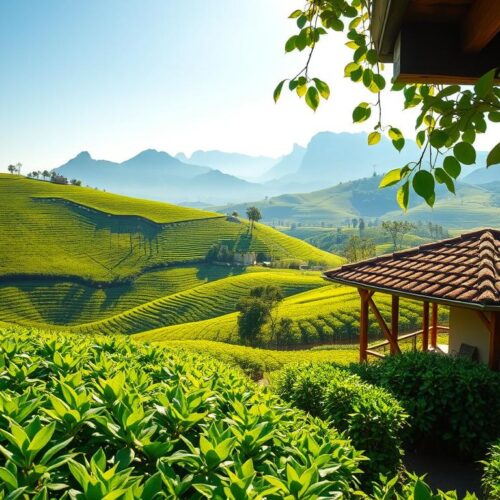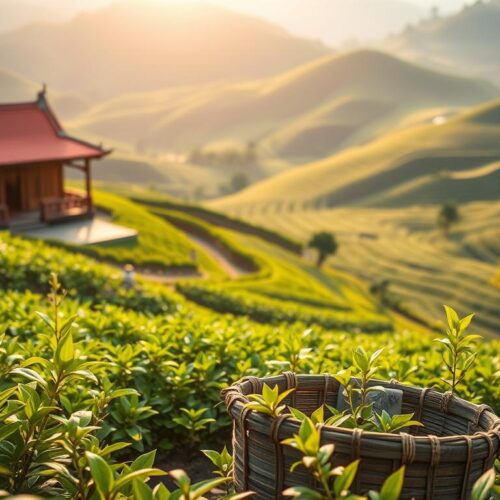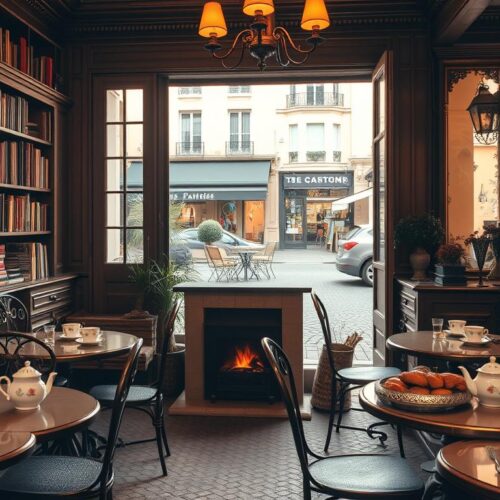You step into the Himalayan foothills, greeted by rising ridgelines and a mist that softly covers the emerald slopes. This enchanting place is Darjeeling, famous for its “Champagne of Teas.” On a tour here, you’ll meet the tea leaves right where they grow, hand-picked on the staggeringly steep terrain ranging from about 1,000 to 2,100 meters. The cool nights, the high humidity, and the gentle sun together slow down the growth of these leaves. This special care brings out deep aromas and flavors, giving your tea notes of flowers, fruits, and muscatel.
Only tea from the Darjeeling district in West Bengal can truly be called Darjeeling tea. This distinction is protected both by India and the European Union. Planning your trip to Darjeeling, you’ll dive into a history that dates back to the 19th century, filled with legends, the effort of countless workers, and the breathtaking landscape. You’ll find estates like Arya, Balasun, and Seeyok gracing the slopes, each celebrated for its unique character and dedication to quality.
Your journey will include a ride on the Darjeeling Himalayan Railway, a UNESCO heritage that snakes through the mountains since 1881. In the tea factories, witness the care put into withering, rolling, oxidizing, and sorting leaves. And, taste the difference in each season’s harvest—First Flush, Second Flush, and Autumnal—each offering a distinct flavor that makes brewing at home a rewarding experience.
This guide is your roadmap to exploring India’s tea plantations, from the misty fields to mastering the perfect cup. It’s packed with advice on water temperature, timing, the best times to visit, and direct estate visits that bring the whole process to life. By the end of this guide, you’ll not only know how to properly read a tea label but also plan your journey and enjoy Darjeeling tea like a true connoisseur.
Why Darjeeling Is Called the “Champagne of Teas”
The phrase matters because of origin. Like Champagne from France and Scotch from Scotland, real Darjeeling tea comes from Darjeeling. It’s protected by India’s Geographical Indication and the European Union’s PGI/IGP. This links the name to a specific place, its people, and their methods.
The taste of Darjeeling earns it the title. The high Himalayan foothills and the cool air slow down the growth of the leaves. This environment creates a tea that’s bright and floral in spring. By summer, it deepens to a muscatel flavor. This complexity is why many call it the Champagne of teas.
The making of Darjeeling tea is an art. Workers hand-pluck shoots on steep slopes in India, where machines would harm the leaves. This careful process keeps the tea’s delicate shape and taste. The estate teams follow strict steps in withering, rolling, and oxidizing. This ensures you can taste the place and the skill in every sip.
| Protected Origin | Region | Legal Status | Why It Matters to You |
|---|---|---|---|
| Darjeeling tea | Darjeeling, West Bengal, India | GI (India), PGI/IGP (European Union) | Authenticity is verified; the name guarantees true origin and flavor. |
| Champagne | Champagne, France | Appellation d’Origine Contrôlée | Protected place of birth ensures the signature sparkle and style. |
| Scotch whisky | Scotland, United Kingdom | Geographical Indication | Production rules preserve identity, aging, and character. |
| Shared Benefit | Distinct terroirs | Enforced standards | You can choose with confidence, knowing the label reflects real provenance. |
- Climate: cool, mist-laden mornings and filtered sun shape a clean, vivid cup.
- Elevation: slow growth heightens aroma and fine texture.
- Handwork: careful plucking on rugged terrain protects leaf integrity.
- Seasonality: spring brings light florals; summer offers the famed muscatel note.
Choosing the Champagne of teas from a trusted estate means you’re part of a tradition. This tradition is safeguarded by law and shaped by the land. This gives you a brew that’s filled with the essence of hillside air, careful farming, and centuries of expertise.
Darjeeling at a Glance: Himalayan Foothills, Elevation, and Estates
Darjeeling is found in northern West Bengal, at the Himalayas’ starting slopes. Here, the climate shapes the famous Darjeeling tea with cool days, brisk nights, and thin air. Most tea gardens are located between 1,000 and 2,000 meters high, with some even higher.
The area has 87 tea gardens, each covering 80 to 500 hectares. Terraced fields and steep slopes require hand-picking, not machines. This careful selection keeps the tea’s high quality, which you taste when you visit Darjeeling.
The air is cool and thin, mixed with mist and high humidity. Rain falls heavily here, about 177 to 381 centimeters annually. This weather makes the tea leaves grow slowly, leading to a rich, floral flavor that Darjeeling tea is known for.
The Arya Tea Estate provides a stunning view of this landscape. It’s perched at 1,500 meters and stretches over 125 hectares of steep land. The conditions here challenge even skilled workers. But, it all contributes to the tea’s unique flavors, especially the muscatel notes.
| Aspect | Typical Range | Impact on Darjeeling Tea | What You’ll Notice |
|---|---|---|---|
| Elevation (m) | 1,000–2,000+ | Slower growth concentrates aromas and briskness | Lighter body with vivid florals and high aroma |
| Rainfall (cm/year) | 177–381 | Even moisture supports tender shoots | Balanced sweetness and clean finish |
| Humidity & Mist | High with persistent fog | Gentle withering on the bush preserves volatiles | Fresh, green notes alongside muscatel depth |
| Terrain | Steep, terraced slopes | Hand-picking selects fine two leaves and a bud | Consistent quality across seasonal flushes |
| Estate Scale | 80–500 hectares | Microclimates across blocks refine character | Distinct lots to explore during Darjeeling travel |
The Himalayan foothills, from ridge to ravine, require expertise to navigate. This terrain blesses us with bright mornings and clouds that drift. It also gives us tea leaves filled with delicate flavors. It’s this unique setting that makes Darjeeling tea special.
The History Behind the Cup: From 19th-Century Origins to Global Fame
Darjeeling tea’s fame began in the 19th century. It was an effort to lessen Britain’s need for Chinese tea. Scottish botanist Robert Fortune brought seeds from China. These seeds made their way across oceans to the Himalayan foothills. There, the cool air and mist gave birth to a new tea identity.
In 1841, Dr. Archibald Campbell, a doctor and plant expert, was working in Darjeeling. He planted Chinese seed stock near a sanatorium. His experiments were successful. In a few decades, steep slopes became known for their tea. This area is now famous for its tea plantations with their unique methods and bright mountain sunshine.
By the late 1800s, tea from this region was in high demand in London and Calcutta. Buyers paid a lot for its unique aromatics. Estates spread across the ridges. This made Darjeeling tea stand out at global auctions.
Arya, formerly known as Sidrabong, is an important part of this history. Buddhist monks made plantings in 1885. The garden still produces tea, showing how traditional methods have adapted over time.
Now, there are laws to protect the tea’s origin and how it’s made. Both India’s Geographical Indication and the European Union’s Protected Geographical Indication rules help. They ensure that only tea from Darjeeling is sold as such. This helps buyers find the real deal in a full market.
Today, Darjeeling produces many types of tea. Yet, First Flush and Second Flush black teas are still the most praised. They remind us that specific techniques and the local environment create a unique taste.
| Milestone | Year | Key Figures/Institutions | Impact on Darjeeling Tea |
|---|---|---|---|
| Chinese seed collection for India | 1840s | Robert Fortune | Introduced hardy Chinese varietals suited to high-elevation tea plantation India conditions. |
| First successful plantings in Darjeeling | 1841 | Dr. Archibald Campbell | Catalyzed estate expansion and defined early cultivation practices for Darjeeling tea. |
| Estate heritage emerges | Late 19th century | Arya (Sidrabong) | Established brand identity linked to mountain terroir and artisanal processing. |
| Global market distinction | Late 1800s | Auctions in London and Calcutta | Secured premium pricing and international recognition for nuanced flavor. |
| Geographical protections | 21st century | India GI; EU PGI | Ensured only tea grown and processed in the district is labeled as genuine Darjeeling tea. |
| Style diversification | Ongoing | Regional estates | Expanded into green, white, and oolong while preserving iconic First and Second Flush black teas. |
The Darjeeling Himalayan Railway: From Tea Transport to UNESCO Icon
In 1881, the Darjeeling Himalayan Railway made a link from the Terai plains to the hill station through an 86 km route. This railway made sure tea could move regularly from gardens to depots. This helped keep tea prices and schedules steady, getting top-quality leaves to ports beyond Kolkata.
At first, steam powered the early trains. Over time, 14 steam locomotives took on the job, making it easier for estates to handle their goods and mail. Then, diesel came along to make things faster and reduce waiting times. The building of a road in 1960 shifted heavy loads away from this narrow path.
The “Toy Train” quickly became a must-do in Darjeeling visits. Its curves, loops, and zigzags turned a simple route into a breathtaking journey. In 1999, UNESCO gave it a nod for its engineering marvels and the tea culture it helped keep alive.
Now, when you hop on, you’re tracing the same route once used by tea leaves going worldwide. The Darjeeling Himalayan Railway lets you see workshops, stations, and hills that are key to this area’s economy and character.
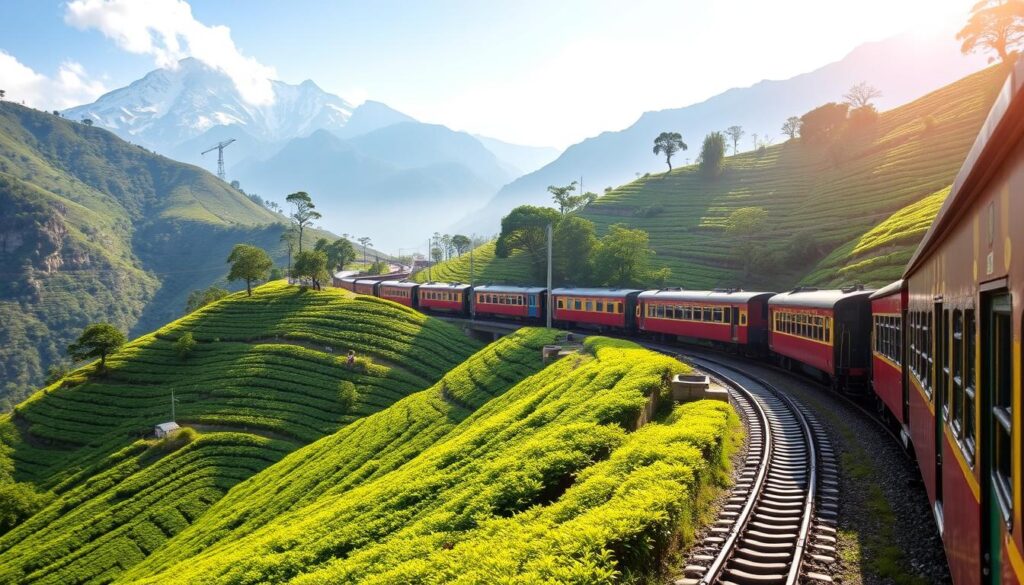
| Aspect | Historical Role | Modern Experience | Why It Matters |
|---|---|---|---|
| Route Length | 86 km corridor linking tea valleys to the hill station | Day rides and heritage trips between key stations | Proved year-round access on steep Himalayan terrain |
| Motive Power | Steam fleet of 14 locomotives over many decades | Mix of restored steam and efficient diesel | Balances authenticity with dependable operations |
| Freight Shift | Primary tea transport before the 1960 road | Passenger focus with light local logistics | Shows how infrastructure adapts to new demand |
| Tourism | Nicknamed the “Toy Train” as popularity grew | Signature highlight of Darjeeling travel itineraries | Transforms an industrial line into a cultural draw |
| UNESCO Status | Inscribed in 1999 for outstanding engineering heritage | Protected landmark with curated services and upkeep | Preserves the link between rail innovation and tea trade |
Inside the Tea Factory: From Withering and Rolling to Oxidation and Sorting
After tea is picked on Indian slopes, it quickly gets to the factory. Keeping Darjeeling tea fresh is key, so workers weigh and record the tea. Then, it’s placed in troughs where cool air starts the drying process. This step, called withering, prepares the leaves for shaping.
Next up is rolling, which begins the tea’s flavor journey. Machines now do the rolling, which used to be by hand. This process crushes the leaves slightly, releasing essential oils. It’s fascinating to smell the tea’s aroma change during this stage.
The process of oxidation is next, similar to how a cut apple turns brown. The tea maker controls this stage carefully. It’s done to achieve the perfect flavor, lighter or deeper depending on the tea. The leaves change to a rich brown, filling the air with a sweet scent.
Then, the tea leaves are dried to stop oxidation and keep the aroma. This step ensures the tea stays fresh and retains its flavor. It produces a crisp leaf that highlights Darjeeling tea’s unique taste.
In the sorting phase, the tea is organized by quality. Different sizes, like whole leaves or dust, are sorted for various uses. This stage ensures the right quality for everything from fine teas to everyday bags. Besides black tea, estates also make green, white, and oolong teas, each with a distinct local flavor.
What you taste comes from careful choices. Every decision, from air flow to processing time, affects the tea’s final taste. With expert handling, these small steps result in a tea that’s complex and satisfying.
Walking through the factory, you see the entire process from leaf to cup. Every piece of equipment plays a part in creating the tea. By the end, the artful production of the tea regions becomes a drink you can enjoy and savor.
Harvest Seasons Explained: First Flush, Second Flush, and Autumnal
Darjeeling tea lets you taste the year through its harvests. Each one follows nature’s cues, with foggy mornings and sunny afternoons. These seasons guide the best times to visit Darjeeling based on your tea preferences.
The First Flush is from late February to May. It’s when new shoots appear after winter’s break. You’ll find a tea that’s light and floral, with a hint of green in its golden color. This is because of its shorter oxidation time.
In this period, tea pickers revisit bushes every 10 to 14 days. You’ll taste delicate flavors, like spring herbs, in your cup. For those who love fresh tastes, early spring is the best time for tastings.
The Second Flush starts from late May to early July. The sun strengthens, leading leaves to mature more. The resulting tea is darker, with hints of ripe fruit and honey, especially from famous estates. It gives a rich, amber-colored tea with lingering flavors.
Autumn brings the third flush in October and November. The air cools and skies clear, creating a toasty tea with a gentle sweetness. It’s less floral than the spring teas and less fruity than summer’s, but very smooth.
To pick the perfect time for your Darjeeling tea trip, consider what flavors you like. Spring is great for light, floral teas. Early summer is best for those who enjoy rich flavors. And fall is ideal for a cozy, smooth taste.
| Season | Typical Window | Leaf & Processing | Flavor Markers | Cup Color | Best For |
|---|---|---|---|---|---|
| First Flush | Late Feb–May | Tender shoots; lower oxidation; leaves may look greenish yet processed as black tea | Light floral, spring herbs, brisk finish | Pale golden | Fans of delicate, fresh Darjeeling tea |
| Second Flush | Late May–Early July | More mature leaves; higher oxidation under stronger sun | Muscatel, fruity richness, honeyed aftertaste | Deep amber | Drinkers seeking body and layered fruit tones |
| Autumnal | October–November | Cool, clear conditions; steady oxidation | Aromatic depth, toasty notes, mellow sweetness | Amber to copper | Those who enjoy smooth, rounded Darjeeling tea |
Choosing the right season depends on what taste you’re after. Use the season’s character to guide which teas you try and buy on your Darjeeling journey.
Terroir and Flavor: How Climate, Mist, and Sunlight Shape Your Cup
When you drink Darjeeling tea, you can really taste the place it comes from. The tea grows in high-altitude gardens in the Himalayas. These gardens are on slopes rich in minerals and covered by fog throughout the day.
Cool nights and bright mornings make the tea leaves grow slow. This slowness packs the leaves with flavors, making your tea taste fresh and vibrant. You’ll notice hints of flowers, citrus, and a special muscatel flavor that’s much loved.
Even with high humidity, the air is crisp and refreshing. The area gets a lot of rain, which helps the tea plants grow deep roots and thick leaves. But it doesn’t take away from the tea’s delicate tastes.
A soft mist keeps the plants cool, preventing any damage to the buds. This means the tea has a lively scent but isn’t too heavy. It leaves a taste in your mouth that’s pleasant and lasts long.
Tea makers watch the weather closely to decide how to process the tea. Cool, clear days mean they’ll keep the oxidation short to preserve a light, spring-like taste. When it’s warmer and sunnier, they let the tea oxidize more for a richer flavor.
This process creates a remarkable difference from Assam tea, which grows in warmer, wetter areas. Assam tea is bold and strong, perfect with milk. Darjeeling tea, grown high in the mountains, remains delicate and refined. This shows how much the land and weather can influence the taste of tea.
Darjeeling tea tour
Plan your Darjeeling tea tour by the heights. Start at Arya Tea Estate’s high slopes. Here, enjoy cool mist and carefully picked tea on narrow paths. Then, visit mid-level gardens near Sonada for teas with a great aroma and body. Finish your journey in the warm Mirik Valley, next to Nepal, where teas have a ripe fruit flavor.
Time your trip to match what tastes you like. If you enjoy bright florals, go between late February and May for the First Flush. For teas with a deep flavor, visit from late May to early July for the Second Flush. Choose October to November if you prefer teas that are aromatic and smooth.
Discover how tea is made by visiting a working factory. See the process from withering to drying. Luxuriate in the texture changes in the oxidation room. Finally, enjoy a tasting session that will teach you about different leaf grades. These include whole leaf, broken, fannings, and dust. Learn how each type reflects the tea’s seasonal flavor.
Take the Darjeeling Himalayan Railway for a unique view. Travel between Kurseong and Darjeeling to see how tea was historically transported. The train’s loops and UNESCO views show how geography impacted tea cultivation. This trip also efficiently connects different estates, making your tea tour memorable.
Organize detailed tastings at different estates. Compare different plant strains and see the effect of location and terrain on the tea. Notice how factors like morning fog and slope influence the taste. Experience these changes as you move from Sonada to the sunnier gardens of Mirik during your journey.
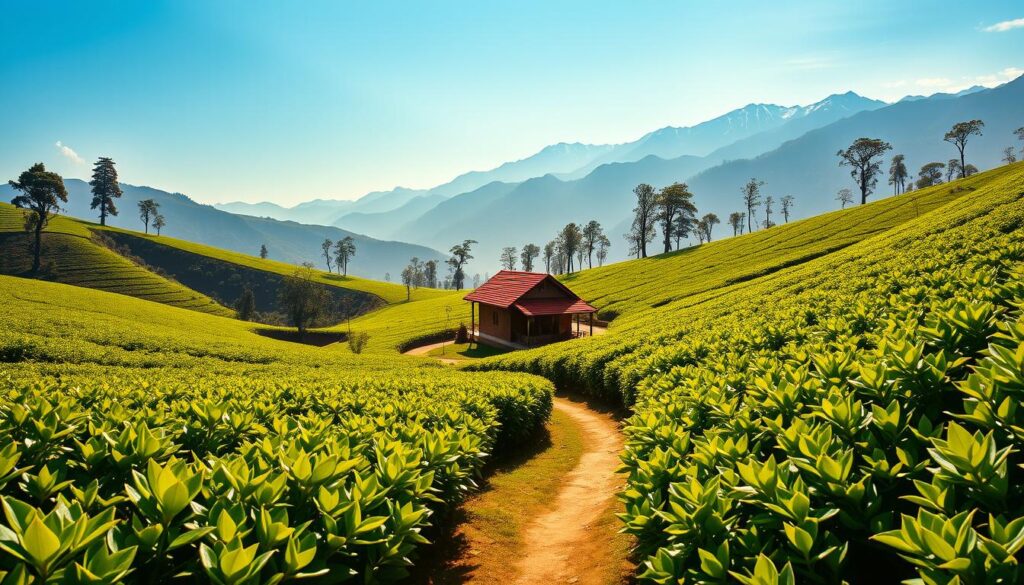
- High elevation: crisp florals, fine astringency, long finish.
- Mid elevation: layered aroma, honeyed body, clean structure.
- Lower elevation: ripe fruit, deeper color, round mouthfeel.
- Book estate permissions and factory slots in advance.
- Schedule harvest days to watch hand-plucking at first light.
- Taste side by side: First Flush vs. Second Flush vs. Autumnal.
- Log notes on clone, altitude, and subregion for each cup.
- Use the Toy Train to link Kurseong, Sonada, and Darjeeling town.
Iconic Estates and Signature Lots: Arya, Balasun, Seeyok, and More
A Darjeeling tea tour lets you explore different estates. Each place gives its tea a unique taste. This happens because of the altitude, plants used, and how the tea is made.
Arya Tea Estate was started in 1885, previously called Sidrabong. It’s known for its special “Jewel” teas. The AV2 clonal character is a standout, with the Diamond First Flush being a prime example. This tea has green leaves, silver tips, and a gentle floral taste. The Ruby Second Flush offers a rich, ruby-brown color with a smooth feel, strong muscatel flavor, and a hint of honey.
When making these teas, aim for water between 85–90°C. Brew the Diamond for 3–5 minutes for a floral flavor. Let the Ruby steep for 5–6 minutes to enhance the muscatel taste. These teas sell out fast, so buy them early when visiting Darjeeling.
Balasun Tea Estate, set up in 1871, spans from 365 to 1,375 meters high near Sonada. It overlooks the Balasun River. Thanks to modern methods, its tea has gotten clearer and more consistent. The April 2022 First Flush mixed three types of plants. This blend offers a floral aroma, deep muscatel flavor, and a smooth honey feel. It starts brisk and ends sweet.
Seeyok Tea Estate, found in 1869 in the Mirik Valley by Nepal, has been making organic tea since 1995. It ranges from 1,100 to 1,800 meters in height. Its April 2022 First Flush uses mainly China plants with some clonal. This tea has soft florals and a citrusy taste. Less oxidation means it’s fresher and rich in antioxidants, perfect for a cold, crisp Darjeeling tea.
These estates help guide your tea choices. Pick Arya for its aromatic teas. Choose Balasun for teas with a mix of flavors and elevations. Opt for Seeyok for its pure, organic teas. This way, your tour through Darjeeling becomes a journey into how the land, the plants, and the makers create unique teas.
How to Brew Darjeeling at Home: Temperatures, Times, and Teapots
You brew Darjeeling tea best with fresh, filtered water. Heat it until just off a boil. Then, warm up your teapot. This keeps your tea tasting great. Store your tea leaves in a tight container in a cool, dark spot. This helps keep their fresh Himalayan scents.
First Flush leaves are tender. Start with water between 80–90°C and steep for 1–2 minutes. If the leaves are a bit more oxidized, 3 minutes work, or even 3–5 for special types like Arya Diamond. Remember to taste your tea as it steeps. Stop when it tastes just right to you.
Second Flush and Autumnal teas need a bit longer to show their rich muscatel and honey flavors. Heat the water to 85–90°C. Begin with 4 minutes, then try 5–6 for stronger teas like Arya Ruby. If the tea starts tasting bitter, steep it for less time or cool the water a little.
Using a teapot and pouring out the tea works well for Darjeeling. In India, some boil tea leaves in water and then strain them. If you boil, keep it short to save the Himalayan aroma. Either way, make sure to pour all the tea out so it doesn’t get too strong.
Pick a teapot that doesn’t absorb tastes. A glass teapot lets you see the tea’s color and keeps the taste pure. A ceramic pot keeps the heat well and doesn’t mix flavors. But don’t use unglazed clay unless you’ll only make one type of tea in it.
Start with 2–3 grams of tea for every 8 ounces of water. Then play with the leaf amount, water temperature, and brewing time. More leaves and a quicker steep make a fuller drink. Less tea and a longer time bring out the top notes. Write down what works for you.
| Flush & Style | Water Temp | Time | Target Notes | Tips |
|---|---|---|---|---|
| First Flush (early spring) | 80–90°C | 1–2 min; up to 3–5 min per estate (e.g., Arya Diamond) | Floral, green almond, spring citrus | Use fresh water, preheat pot, decant fully for a clean finish |
| Second Flush | 85–90°C | 4–6 min (e.g., Arya Ruby 5–6 min) | Muscatel, stone fruit, honeyed depth | Increase time in 30-second steps to avoid bitterness |
| Autumnal | 85–90°C | 4–6 min | Warm spice, toasted grain, amber sweetness | Use ceramic for steadier heat and a rounder body |
| Everyday Western Method | Just off boil | As above by flush | Balanced cup with clear liquor | 2–3 g per 8 oz; adjust leaf for strength |
| Indian Boil-and-Strain | Gentle simmer | 1–3 min simmer, then strain | Robust body, brisk finish | Keep simmer short to protect aromatics from the Himalayan foothills |
If your tea tastes too weak, add more leaves or steep it longer. If it’s too strong, use cooler water or steep it for less time. Tiny changes can really improve your tea. You can make a lighter First Flush or a deeper Second Flush. All while keeping the unique taste Darjeeling is known for.
Planning Your Darjeeling Travel: When to Go and What to See
Plan your Darjeeling trip with the tea harvest and weather in mind. Visit from late February to May for the First Flush’s freshness and cool, misty mornings. For the Second Flush’s muscatel flavors, go between late May and early July. October to November is perfect for clear views and Autumnal teas.
Anchor your days around the Darjeeling Himalayan Railway. Take a journey on parts of this 86 km UNESCO treasure. It runs between New Jalpaiguri, Kurseong, and Darjeeling, showing off historic tea trails. Expect romantic steam engine stretches. Remember, mountain weather and tricky roads might affect travel.
Get permits early for tours of tea fields and factories. Head to Arya for its steep slopes and exceptional teas. Explore areas like Sonada and the Mirik Valley by the Nepal border at Seeyok. This will show you how elevation and location change tea flavors.
Try different teas side by side to understand their unique tastes. Compare AV2 clones with traditional China and Assamica bushes. Notice differences in leaf shape, scent, and tea strength. Enjoy these tastings with walks in the hills. Wait for the mists to clear for a breathtaking view of Kanchenjunga.
Plan with breaks in mind. Leave free time between drives, tea sessions, and train rides. This flexibility is key if the weather changes or a tea tasting extends unexpectedly.
- Late Feb–May: First Flush gardens, cool mornings, brisk teas.
- Late May–early July: Second Flush, muscatel notes, lush hillsides.
- Oct–Nov: Autumnal teas, clear mountain views, drier roads.
- Focus areas: Arya’s high slopes; Sonada; Mirik Valley around Seeyok.
- Essentials: advance estate permissions; buffer days; layered clothing.
Conclusion
You’ve discovered the journey of Darjeeling tea from its foggy hills to your mug. Its unique character is safeguarded by India’s GI tag and the EU’s PGI. This ensures its quality, coming from the Himalayas, where leaves are picked by hand at high altitudes. And where precise craftsmanship in factories brings out its best flavors. This is how the location, the making, and the taste come together. This blend of elements makes visiting Darjeeling for its tea both a humble and unique experience.
The time of year guides your tea selection. The First Flush offers a taste of bright flowers and fresh spring greens. The Second Flush brings out a rich muscatel flavor distinct to Darjeeling. And teas from the Autumnal Flush have a deeper taste. The 1881 Darjeeling Himalayan Railway, a UNESCO site since 1999, connects all these experiences. It used to transport tea and is now a symbol that escorts you through India’s tea landscapes.
Famous tea estates show the importance of height and tea plants in shaping taste. Arya, Balasun, and Seeyok produce exceptional teas like Arya Diamond and Ruby by perfecting every step of the process. Certain tea plants, especially AV2, are best grown high up. They give off complex aromas and a lingering taste when made with fresh water in the right vessel.
At home, brewing tea correctly with the right water temperature and brewing time pays homage to the tea. If you visit, you can savor your tea among clouds and the scent of cedar. Whether you travel to Darjeeling or enjoy its teas at home, the area invites you with subtle flavors, clear tastes, and a rich history. This is why it’s called the “Champagne of Teas.”

